jeudi, 27 septembre, 2018
Saviez-vous que votre CEEFIT by Seaver mesurait la cadence et le rebond de votre cheval au travail ? Mais que signifient ces termes exactement ? Dans cet article, nous vous donnons les clés pour comprendre ces deux fonctionnalités et leurs intérêts pour le travail de votre cheval au quotidien.

La cadence correspond au nombre de foulées effectuées par minute, à une allure donnée. Une foulée représente l’ensemble des mouvements séparant deux posés successifs d’un même membre à une allure donnée. Il s’agit en quelque sorte du rythme du cheval.
Modifier la cadence revient donc à faire plus de foulées ou moins de foulées dans un temps donné. Avoir une cadence régulière permet au cheval de bien s’équilibrer et de rebondir dans ses allures. Ainsi, ce dernier pourra mieux engager et donc mieux répondre à vos demandes.
Afin d’évaluer la régularité de votre cheval, votre CEEFIT vous donne l’évolution de la cadence, c’est à dire du nombre de foulées par minute, au cours de votre séance, en distinguant par des couleurs les passages à chacune des allures : bleu pour le pas, orange pour le trot et vert pour le galop.
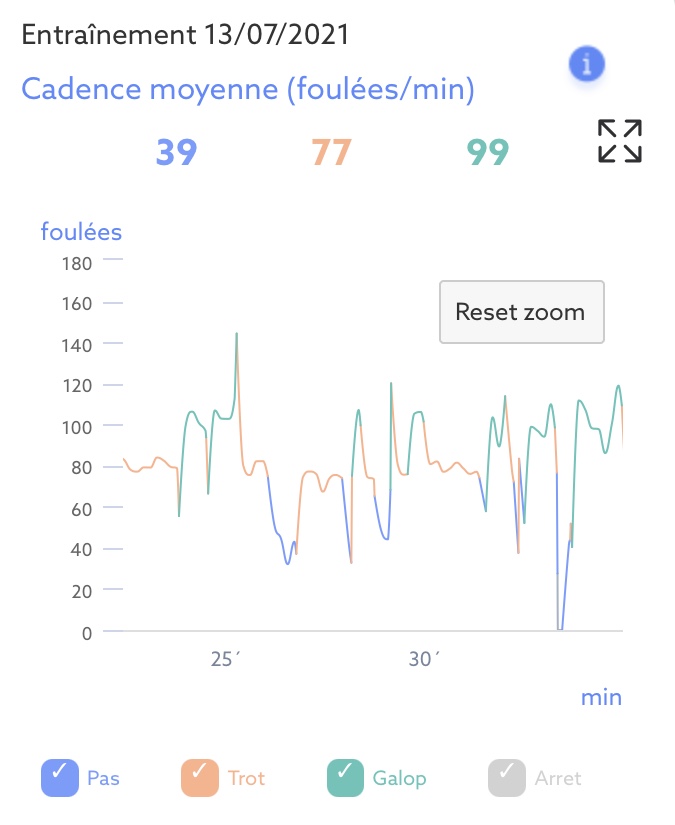
Nous constatons que le cheval accélère légèrement son galop avant de repasser au trot, peut-être par opposition ou perte d’équilibre. Un phénomène à surveiller et à travailler s’il se produit systématiquement.
Un cheval effectue en moyenne entre 35 et 60 foulées par minute au pas, entre 55 et 100 foulées par minute au trot et entre 80 et 130 foulées par minute au galop. Il s’agit bien entendu de moyennes. Certains chevaux pourront parfois se situer au dessus ou en dessous de ces fourchettes. Par exemple, un trotteur en pleine course pourra aisément dépasser les 120 foulées de trot par minute.
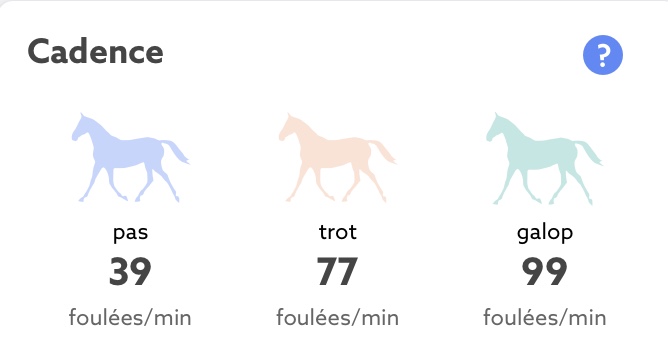
L’application vous donne également une indication de comparaison entre cette séance et la séance dernière.

Dans l’exemple ci-dessus, la régularité de la cadence au trot est parfaite. Cependant, le cheval a effectué 5 foulées de moins par minute au galop qu’à la séance précédente. Ce n’est pas énorme mais cela nous donne une indication. L’objectif de cette séance était de travailler le galop-pas, ce qui nous indique que la cavalière a eu tendance à freiner son cheval plutôt qu’à le rassembler (ce que l’on recherche lors du travail du galop pas). Ces informations donnent des axes d’amélioration pour les séances à suivre.
Le travail latéral et longitudinal (allongement, rassembler) peut faire baisser la régularité, de même qu’un changement de sol en extérieur.
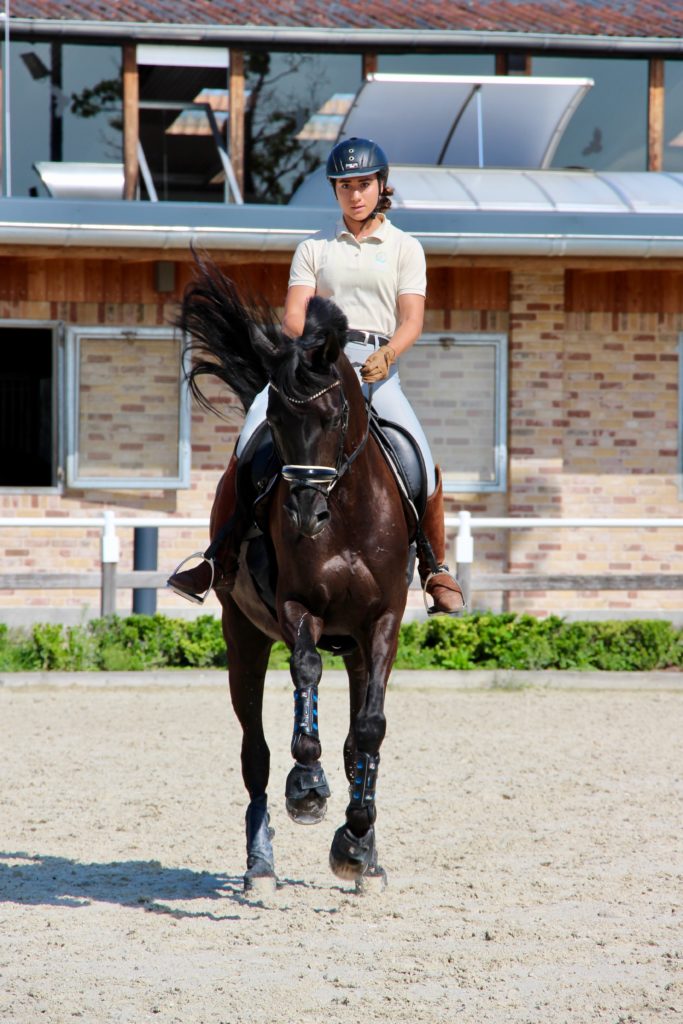
Lorsque vous prenez un cours avec votre coach, il peut être intéressant d’observer les données de cadence obtenues pour une allure ou un exercice donné. Ainsi, lorsque vous travaillerez seul à la maison, l’objectif sera de retrouver les mêmes valeurs.
Les données de cadence peuvent également vous aider à valider des allongements. Pour ce faire, il vous faudra vérifier que la cadence varie peu et n’augmente pas lors de votre allongement, comme cela est souvent le cas pour des chevaux ou cavaliers en début d’apprentissage.
Le rebond correspond à l’amplitude du déplacement vertical de votre cheval. Il permet de travailler la verticalité des allures : plus ces dernières auront du rebond et plus votre cheval sera propulsé en hauteur.
Afin d’évaluer le rebond de votre cheval, nous vous donnons l’évolution du déplacement dorso-ventral en centimètres, au cours de votre séance, en distinguant par des couleurs les passages à chacune des allures : bleu pour le pas, orange pour le trot et vert pour le galop. Vous trouverez également une moyenne au pas, au trot et au galop.
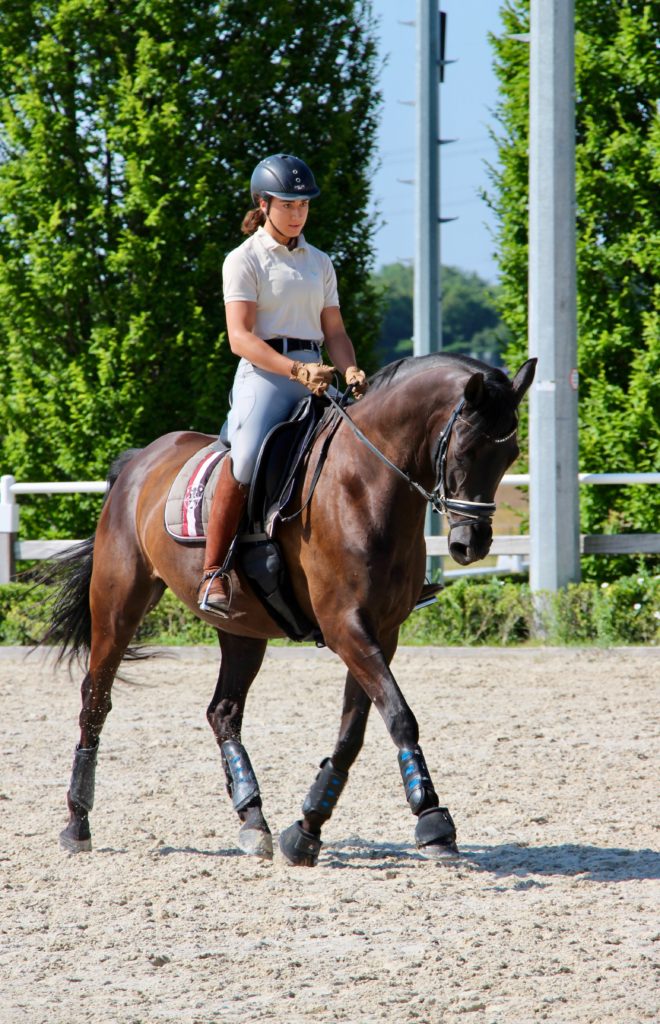
Un cheval a un rebond moyen compris entre 1 et 5 cm au pas, entre 5 et 15 cm au trot et entre 10 et 25 cm au galop. Encore une fois, il s’agit ici de moyennes. Des variations de rebond pourront être observées en fonction de la race, de la conformation ou encore de la taille du cheval. Certains équidés pourront avoir un rebond inférieur ou supérieur à ces valeurs sans pour autant s’inquiéter.
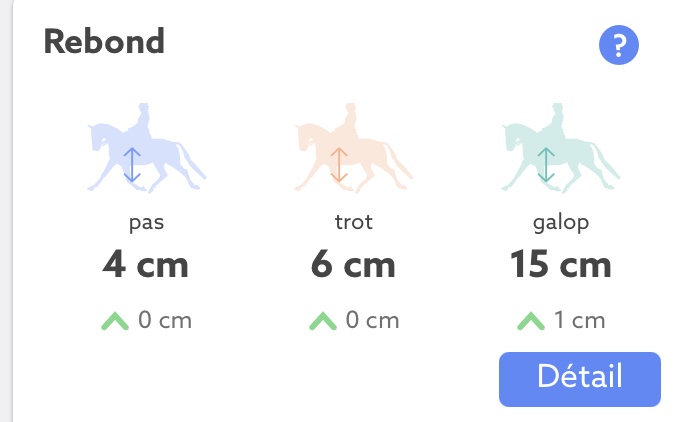
Il est bon de noter que si un cavalier de dressage va chercher à faire augmenter ces valeurs par le travail, d’autres disciplines requièrent un cheval “rasant” avec un rebond bas, comme par exemple l’endurance (afin de limiter la fatigue) ou le western pleasure.
Comparer le rebond lors de vos différents exercices est utile pour comprendre ce qui vous permettra de l’améliorer. Il ne faut pas oublier que le rebond a tendance à augmenter avec le travail sur des barres au sol ou des cavaletti.

Ci dessus, nous pouvons observer l’évolution du rebond lors de passage d’un cavaletti suivi d’une transition descendante barres au sol. Nous remarquons bien l’augmentation du rebond sur le cavaletti.
A vous de jouer maintenant 😉
L’équipe Seaver